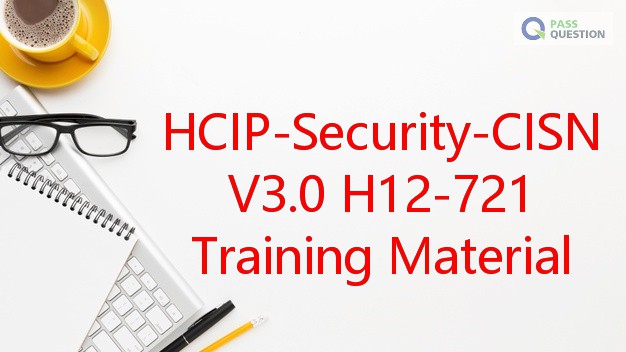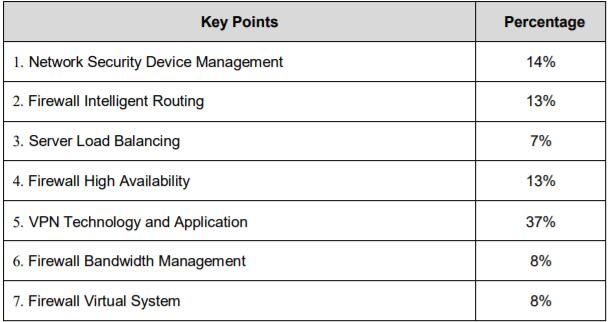HCIP-Security-CISN V3.0 H12-721 Training Material
Are you planning to prepare for your H12-721 HCIP-Security-CISN V3.0 exam? PassQuestion provides the latest HCIP-Security-CISN V3.0 H12-721 Training Material which can ensure you pass at the first time to participate in the HCIP-Security-CISN H12-721 exam. With high quality HCIP-Security-CISN V3.0 H12-721 Training Material by PassQuestion provided, you will certainly pass the Huawei H12-721 exam. You also can find valid H12-722 and H12-723 Training Material from PassQuestion to best prepare for your HCIP-Security Certification.

HCIP-Security-CISN V3.0 Exam Overview
HCIP-Security certification certifies you master Huawei's network security technologies (including network perimeter security, application security, terminal security, etc.), and have the architecture design, deployment, and operation and maintenance capabilities of enterprise network security, to achieve overall network wireless intrusion and DDoS/APT attack defense, and to protect enterprise information assets.There are 3 exams(H12-721,H12-722,H12-723)to get this HCIP-Security certification.

HCIP-Security-CISN V3.0 Exam Knowledge Points
HCIP-Security-CISN V3.0 exam covers network security device management, firewall intelligent routing, firewall high availability, VPN technology and application, firewall bandwidth management and virtual firewall technology.

1. Network Security Device Management
1.1 Network Security Device Management
1.2 Network Security Device Log Analysis
1.3 Network Security Device Unified Operation and Maintenance
2. Firewall Intelligent Routing
2.1 Principles of Intelligent Routing
2.2 Intelligent Routing Application Analysis
2.3 Intelligent Routing Troubleshooting
3. Server Load Balancing
3.1 Principles of SLB Technology
3.2 SLB Deployment
4. Firewall High Availability
4.1 IP-Link Technology
4.2 BFD Technology
4.3 Hot Standby
4.4 Link-group Technology
4.5 Eth-Trunk Technology
5. VPN Technology and Application
5.1 IPSec VPN Technology and Application
5.2 SSL VPN Technology and Application
6. Firewall Bandwidth Management
6.1 Principle of Firewall Bandwidth Management
6.2 Firewall Bandwidth Management Deployment
6.3 Firewall bandwidth management Troubleshooting
7. Firewall Virtual System
7.1 Principle of Firewall virtual system
7.2 Firewall Virtual System Deployment
7.3 Firewall Virtual System Troubleshooting
View Online HCIP-Security-CISN V3.0 H12-721 Free Questions
1. Users cannot access intranet resources when using the network extension function. Which of the following are not possible causes of the failure?
A. Did you obtain a virtual IP address on the virtual network card of the user's PC?
B. The route between the firewall and intranet server is unreachable.
C. User connection is timeout.
D. The virtual IP address conflicts with the FW interface address, intranet server address, and DHCP address pool address.
Answer: C
2. On a hot standby networking, if the peer heartbeat interface address is specified when the HRP heartbeat interface is configured, which of the following types of packets is the VGMP hello packet sent between the firewalls?
A. Unicast packets
B. Broadcast packets
C. Multicast packets
D. UDP packets
Answer: A
3. The bandwidth management function only supports limiting the number of connections initiated by a specified IP.
A. True
B. False
Answer: B
4. When using the Radius server to authenticate users, you need to configure the corresponding username and password on both the Radius server and the firewall.
A. True
B. False
Answer: B
5. About the description of the process of network expansion, which statement is wrong?
A. After the network extension function is triggered, an SSL VPN tunnel needs to be established first between the remote user and the virtual gateway.
B. The remote user's local PC automatically generates a virtual network adapter. The virtual gateway randomly selects an IP address from the address pool and assigns it to the remote user's virtual network adapter.
C. After the remote user virtual network adapter obtained the private IP address, it need to manually configure the route to the intranet server so that the internal network resources can be accessed normally.
D. The remote user sends a business request packet to the Server on the intranet. The packet arrives to the virtual gateway through the SSL VPN tunnel.
Answer: C
6. In the IDC room, a Huawei USG6000 series firewall can be divided into several virtual systems. Then, the root firewall administrator generates virtual system administrators to manage each virtual system separately.
A. True
B. False
Answer: A
- TOP 50 Exam Questions
-
Exam
All copyrights reserved 2026 PassQuestion NETWORK CO.,LIMITED. All Rights Reserved.

